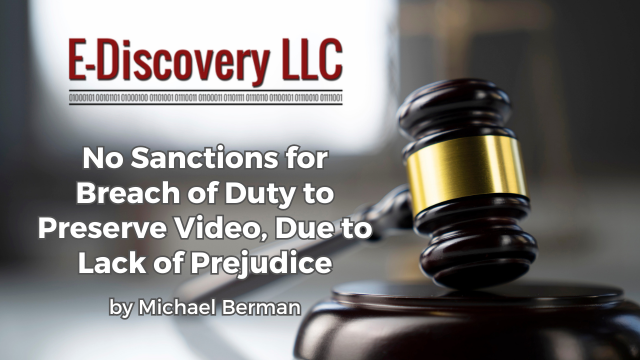
[EDRM Editor’s Note: The opinions and positions are those of Michael Berman.]
“[W]hile I find defendants negligently failed to preserve video footage, I find they are not guilty of spoliation because such footage is not responsive to plaintiff’s discovery requests or relevant.” Hobson v. [Correctional Officer] Harper, 2025 WL 1905594 (D. Nev. Jul. 9, 2025).
Plaintiff’s civil rights claims arose out of alleged destruction and loss of his property when his cell was searched on June 2, 2022. He also alleged “late-night cell searches” that were retaliation for his having filed a grievance about the first search. Those “late-night” searches were allegedly conducted through August 2023.
PLAINTIFF’S DISCOVERY REQUEST AND PARTIES’ CONTENTIONS
While there were other discovery disputes, Mr. Hobson’s request was for: “Video footage from inside and outside of laundry on 6-3-22 to 6-30-22 and video footage from Unit 4 rotunda, and C wing on 1-1-22 to 6-22-22.” In short, he sought: (1) video from areas away from his cell (the laundry) on the month of the first cell search; (2) video for days that pre-dated that first cell search; and, (3) videos including and after the date of that search, but not all the way until August 2023, for Unit 4 and C wing.
Mr. Hobson argued:
[D]efendants operate and maintain surveillance camaras [sic] throughout the corrections institute housing him that capture continuous video recordings, including near the cell where the alleged June 2, 2022, search and subsequent searches occurred…. Plaintiff further argues that defendants save footage from the surveillance camaras.
Hobson v. [Correctional Officer] Harper, 2025 WL 1905594 (D. Nev. Jul. 9, 2025).
In response, defendants:
[A]cknowledge that their cameras operate on a loop recording system that preserves surveillance footage for a period of time before it is automatically recorded over…. Defendants claim that no potentially responsive surveillance video footage exists because it was likely deleted due to the general operation of the video recording system.
Id.
THE DUTY TO PRESERVE
The Hobson court wrote that the duty to preserve relevant information “is one of the most basic, well-established, and widely accepted litigation tenets.” It is triggered when a potential party has “some notice that the evidence is potentially relevant to… reasonably foreseeable litigation.”
The notice component is a low, objective standard “that asks not whether the party in fact reasonably foresaw litigation, but whether a reasonable party in the same factual circumstances would have reasonably foreseen litigation.”
Id.
In other words, the trigger analysis is objective, not subjective. Once the duty is triggered, the court wrote that a potential party must take reasonable steps to preserve “potentially relevant information.”
Some of the spoliation evidence in Hobson was redacted and sealed for prison security reasons and “[i]n light of these restrictions requested by defendants, [the court’s] discussion and analysis regarding defendants’ preservation efforts and relevancy of erased footage are limited to protect the safety and security of staff and inmates.” Obviously, this blog is similarly limited.
DEFENDANTS’ “SNAIL MAIL” DID NOT PROVIDE A “SAFE HARBOR”
Mr. Hobson tried, but failed, to give timely notice of the duty to preserve video. The defendants’ “prison policy” involved a cumbersome process called “kites.” Inmates had to submit a written “kite” to raise an issue. A kite must first be signed by a unit officer. It then goes into the offender’s unit mailbox and next must be processed and delivered to the mailroom.
Mr. Hobson submitted several kites to put defendants on notice of their duty to preserve surveillance video footage. In one kite, he stated that he would file suit and needed the video for discovery. Kites referred to the cell search incident.
Michael Berman.
“Once an inmate has completed and submitted a kite in the mailbox, it can take anywhere from three to ten days for the kite to be delivered to the prison staff member to whom the kite was addressed…. It then takes an additional undisclosed amount of time for prison staff to go through kites received…. Kites addressed to Associate Wardens generally take longer due to the volume of kites they generally receive.”
Mr. Hobson submitted several kites to put defendants on notice of their duty to preserve surveillance video footage. In one kite, he stated that he would file suit and needed the video for discovery. Kites referred to the cell search incident.
Mr. Hobson’s timely “snail mail” was not delivered in time. As a result, the defendants claimed lack of notice at the time of deletion of the video. The court wrote:
In sum, because plaintiff submitted his kites to the mailbox on June 3, 2022, a Friday, defendants did not eventually process and review his kites until after video footage had been automatically erased and taped over as the result of the regular camera system operations…. Defendants claim that no potentially responsive surveillance video footage exists because it was likely deleted by operation of their video recording system. [Emphasis added].
Id.
In short, that is the “safe harbor” defense to a spoliation claim. It is an assertion that the loss of ESI due to the routine, good faith operation of an information technology system does not support sanctions.
The pre-2015 “safe harbor rule” in Fed.R.Civ.P. 37, precluded sanctions under the Rules, absent exceptional circumstances, when ESI went missing because of the routine, good faith operation of an information technology system. It was abandoned by the Federal Rules in December 2015. See Felder Part 4 of 4: Was the Felder Defendant’s 14-Day Video Overwriting Policy Defensible? (Aug. 22, 2024); M. Berman, “It is Time to Replace Maryland’s ‘Safe Harbor’ Rule,” Maryland State Bar Ass’n. White Paper (2022).
DEFENDANTS DID NOT IMPOSE A LITIGATION HOLD
The Hobson court was unimpressed with the “routine operation” argument. While not stated in the decision, that defense was superseded by current Fed.R.Civ.P. 37(e) in December 2015.
The Hobson court wrote:
Defendants do not have potentially responsive surveillance video because they did not suspend the automatic deletion of video footage feature in their video recording system after receiving plaintiff’s notice/kite to preserve. Once a party is on notice of potential litigation, it must suspend its destruction policies or operations “and put in place a ‘litigation hold’ to ensure the preservation of relevant document.”
Id.
Defendants made an argument that, in my words, under their cumbersome “kite” system, video is erased before a complaining inmate’s kite is delivered and therefore they were not on notice of the claim at the time the ESI was erased, thus precluding sanctions. The Hobson court wrote:
Defendants argue that the time from when plaintiff submitted his kites to the time the kites could have been reviewed (and a litigation hold put in place preserving footage) was longer than the period of time that video footage is kept then automatically erased by the recording system.
Id.
The court found the defense unacceptable. Mr. Hobson submitted kites a day after the cell search and the court explained: “The delay in reviewing plaintiff’s kites given the intervening weekend and processing and review times in relation to the time video footage is automatically erased is not reasonable. It did not give sufficient time to review plaintiff’s kite and place a litigation hold to retrieve and preserve relevant footage before the footage was automatically erased.” It wrote:
While defendants explain why video was erased, they do not show how they complied with their duty to preserve. I find that defendants’ timeline in this case is not reasonable and that defendants failed to meet their preservation duties.
Id.
In my words, the defense was that the prison created a snail-like communication system when it had a lightning-fast erasure policy and therefore it had no preservation duty. That is a “Catch-22.”1 The Hobson court found that the duty was triggered and breached by the erasure after the duty had arisen.
DESPITE BREACH OF THE DUTY, THERE WAS NO PREJUDICE
The Hobson court looked to its inherent power to address spoliation. Id. at *5. Respectfully, I suggest that video is ESI and that the inherent power was displaced by the December 2015 amendment to Fed.R.Civ.P. 37(e).
While the Hobson court found that: (1) defendants had sole control over the video system; (2) Mr. Hobson’s notice triggered their duty to preserve, and, (3) defendants were negligent, it did not impose sanctions, stating: “I find that the erased footage was not relevant to the plaintiff’s claims nor responsive to his discovery requests. Therefore, I conclude that defendants are not guilty of spoliation. My determination is without prejudice.”
I find that the erased footage was not relevant to the plaintiff’s claims nor responsive to his discovery requests. Therefore, I conclude that defendants are not guilty of spoliation. My determination is without prejudice.
Hobson v. [Correctional Officer] Harper, 2025 WL 1905594 (D. Nev. Jul. 9, 2025).
Defendants did not dispute that the searches occurred. The court wrote that: “If defendants dispute the alleged searches at issue were conducted at all, spoliation may be an issue because erased video footage may be relevant to show searches were conducted.”
Instead, the court wrote: “At issue is whether the searches after were done solely to harass plaintiff, destroy his property, and without justification.”
The temporal scope of the discovery request was significant. Mr. Hobson’s claim focused on a June 2, 2022, search of his cell. He claims that later “destructive” searches took place through August 2023 in retaliation.
However, the court wrote that: “Plaintiff, … does not request video footage of his cell being searched at any relevant time. Instead, Plaintiff requests footage from between January 1, 2022, and June 30, 2022, for various locations outside of his cell, including the laundry facility, the Unit 4 rotunda, and the C-wing in general.”[Emphasis added].2
The court added: “Moreover, the unredacted Portillo Declaration that I reviewed in camera sufficiently demonstrates that no relevant footage was erased as the result of the video system’s automatic erase and record-over feature…. Therefore, defendants are not guilty of spoliation.”
THOUGHTS
Clearly, the Hobson court had information – redacted and sealed due to prison security issues – that are not available to others.
Much like Hobson, in another recent decision, Sanctions [Were] Denied Because of Lack of Prejudice, Despite Breach of Duty to Preserve Video (Jun. 16, 2025). There, the Court held that relevance for spoliation purposes is more stringent than relevance for evidentiary purposes. Like Hobson, the court there did not apply Fed.R.Civ.P. 37(e). The blog explains that some courts have written that video footage is not ESI. Others disagree.
While the Hobson court relied on its inherent power, under its findings of mere negligence and no prejudice, the same result would likely have been reached under Fed.R.Civ.P. 37(e)(1).
Preservation and discovery of surveillance video is a much litigated issue because of both rapid overwriting and difficulty of showing what missing video would have captured. “Issues around surveillance and security video footage have generated a cottage industry of cases.” See Felder Part 3 of 4: Defendant’s Overwriting of Video Footage After 14 Days Held Not to be Spoliation (Aug. 21, 2024)(citations omitted).
Overwriting is a frequent issue. Felder Part 3 of 4: Defendant’s Overwriting of Video Footage After 14 Days Held Not to be Spoliation (Aug. 21, 2024). A policy of overwriting video after six weeks was permitted in Maryland’s Intermediate Court Affirms Denial of Sanction for Spoliation of Video Evidence (Jan. 9, 2021).
While Hobson involved the unique context of prison security, I have suggested that rapid overwriting of video may not be defensible. Felder Part 4 of 4: Was the Felder Defendant’s 14-Day Video Overwriting Policy Defensible?(Aug. 22, 2024). If, for example, store video is overwritten in 14 days and a plaintiff requests preservation after that, is the policy reasonable in light of the low cost of storage?
It is often difficult to demonstrate what a missing video would have shown. In one recent case, a store had 30 cameras; however, plaintiff could not show that they captured the area of the alleged tort. The Court wrote that “Petitioner argues that the [spoliation] instruction was warranted because the jury could infer the existence of the video based on the fact that Giant had security cameras mounted in the area where the injury occurred. We remain unpersuaded.” No Spoliation Instruction Regarding Surveillance Video in Supermarket Personal Injury Case (Jan. 16, 2022); but cf. Maryland’s High Court Affirms Sanction for Spoliation of Video Evidence Jan. 8, 2021)(“There was evidence in the record that the camera was pointed in a direction that would have captured persons present on Steamfitters’ property prior to and at the time of the fire, as well as a portion of the property close to the origin of the fire. Video of that area may have captured other evidence similar to the evidence captured by the other video cameras, which were shown to the jury, such as the color of the smoke, wind direction, and speed.”).
In one (remarkable?) decision, the court agreed that Trust Me: Nothing in the Missing Video Would Have Helped You! (Sep. 10, 2024). There, defendant testified that it reviewed the video after the alleged tort and that it did not capture the incident. Sanctions were denied. I suggested a different analysis. Could a defendant destroy incident reports and claim that they were all exculpatory? Can a potential litigant wipe a key custodian’s text messages or emails and testify “trust me, I looked at them and they would not have helped the adverse party?”
Maryland courts have held that the absence of records does not equate to failure to preserve, absent more evidence. E.g., M. Berman and A. Shelton, “The Common-Law Duty to Preserve,” in M. Berman, et al., eds., “Electronically Stored Information in Maryland Courts” (Md. State Bar Ass’n. 2020), 159 discussing Solesky v. Tracey, 2009 WL 8606518 (Md. Cir. Ct. Balt. Co. May 29, 2009).
In some instances, Secondary Evidence of Missing [is] Video Permitted (Dec. 10, 2023); see Satisfactory Secondary Evidence Prevents Sanction (Sep. 4, 2021). Fed.R.Civ.P. 37(e) expressly incorporates that concept.
Other issues related to replacement evidence may arise. In Defendant’s Failure to Preserve Surveillance Video Supports Waiver of Investigator’s Fact Work Product (Nov. 26, 2024), after defendant’s inadvertent failure to preserve video footage, a subpoena of an investigator’s work product was permitted.
In Hobson, the pro se plaintiff’s discovery request was deemed misfocused. Procedural flaws are not unusual. Procedural Failures in Request to Preserve Video Evidence (Feb. 23, 2023); see The Perils of a Misfocused Preservation Letter (Jul. 22, 2021); A Focused Preservation Letter (Mar. 9, 2022). For example, in one recent auto tort, the failure to timely demand preservation of video was deemed important – in my view, incorrectly – among other factors. Should Carl Little, Jr., Have Won His Appeal Challenging Denial of a Spoliation Instruction? (Dec. 26, 2022).
Hobson shows the need for a prompt preservation notice, and a focused discovery demand. A motion for spoliation sanctions should be addressed to potentially responsive information meeting the needs of the strict relevance test under the sanctions doctrine. Further, it is important to consider each provision of Fed.R.Civ.P. 37(e).3
Notes
- Catch 22 is a 1961 novel by Joseph Heller. “The ‘catch’ in Catch-22 involves a mysterious Army Air Forces regulation which asserts that a man is considered insane if he willingly continues to fly dangerous combat missions but that if he makes the necessary formal request to be relieved of such missions, the very act of making the request proves that he is sane and therefore ineligible to be relieved.” Catch-22 | Summary, Analysis, & Facts | Britannica ↩︎
- The request for footage through June 30, 2022, would cover footage on the day of the event, June 2, 2022, and some of the alleged subsequent searches through June 30th. Apparently, however, it would not include Mr. Hobson’s cell. ↩︎
- The sanctions rule in Maryland State courts was amended in November 2023. Rule 2-433(b) is significantly different than Fed.R.Civ.P. 37(e). Maryland Rules Order Amends Sanctions Rule (Nov. 28, 2023); Maryland Supreme Court Rejects Proposed Sanctions Rule Paralleling Fed.R.Civ.P. 37(e) (Nov. 3, 2023). ↩︎
Assisted by GAI and LLM Technologies per EDRM GAI and LLM Policy.


